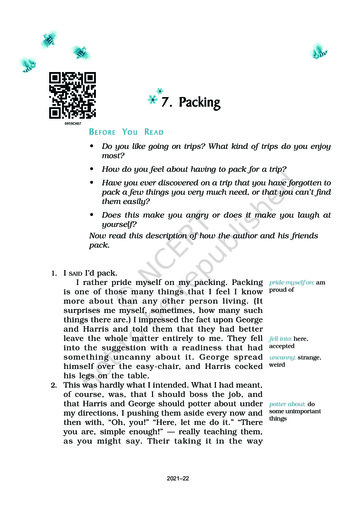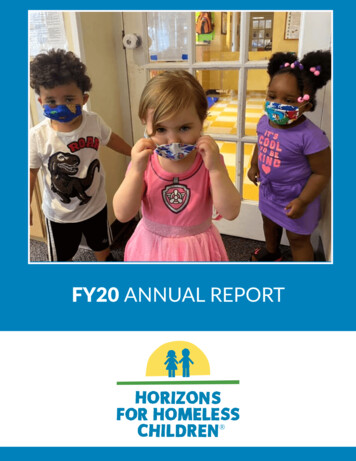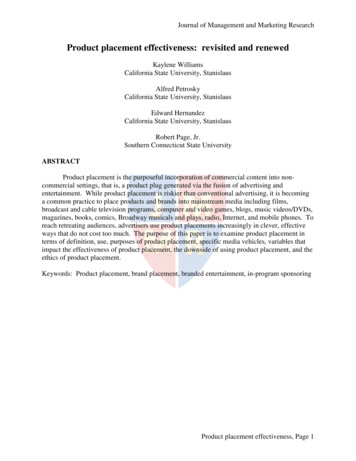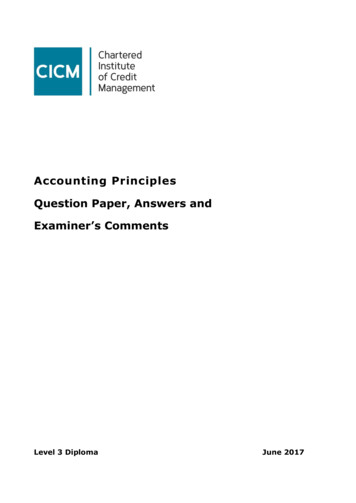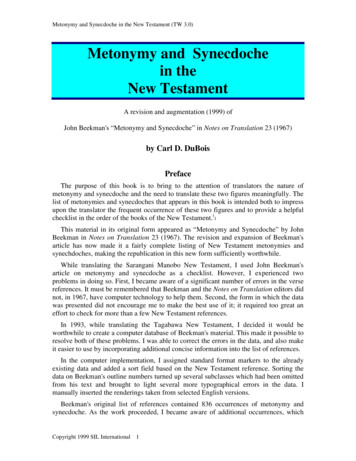
Transcription
Metonymy and Synecdoche in the New Testament (TW 3.0)Metonymy and Synecdochein theNew TestamentA revision and augmentation (1999) ofJohn Beekman's “Metonymy and Synecdoche” in Notes on Translation 23 (1967)by Carl D. DuBoisPrefaceThe purpose of this book is to bring to the attention of translators the nature ofmetonymy and synecdoche and the need to translate these two figures meaningfully. Thelist of metonymies and synecdoches that appears in this book is intended both to impressupon the translator the frequent occurrence of these two figures and to provide a helpfulchecklist in the order of the books of the New Testament.i1This material in its original form appeared as “Metonymy and Synecdoche” by JohnBeekman in Notes on Translation 23 (1967). The revision and expansion of Beekman'sarticle has now made it a fairly complete listing of New Testament metonymies andsynechdoches, making the republication in this new form sufficiently worthwhile.While translating the Sarangani Manobo New Testament, I used John Beekman'sarticle on metonymy and synecdoche as a checklist. However, I experienced twoproblems in doing so. First, I became aware of a significant number of errors in the versereferences. It must be remembered that Beekman and the Notes on Translation editors didnot, in 1967, have computer technology to help them. Second, the form in which the datawas presented did not encourage me to make the best use of it; it required too great aneffort to check for more than a few New Testament references.In 1993, while translating the Tagabawa New Testament, I decided it would beworthwhile to create a computer database of Beekman's material. This made it possible toresolve both of these problems. I was able to correct the errors in the data, and also makeit easier to use by incorporating additional concise information into the list of references.In the computer implementation, I assigned standard format markers to the alreadyexisting data and added a sort field based on the New Testament reference. Sorting thedata on Beekman's outline numbers turned up several subclasses which had been omittedfrom his text and brought to light several more typographical errors in the data. Imanually inserted the renderings taken from selected English versions.Beekman's original list of references contained 836 occurrences of metonymy andsynecdoche. As the work proceeded, I became aware of additional occurrences, whichCopyright 1999 SIL International 1
Metonymy and Synecdoche in the New Testament (TW 3.0)Beekman had not included. I added these to the database. I also added several morepoints to Beekman's original outline and edited and rearranged the outline itself.The suggestions given in the present list of references for adjusting individualoccurrences of metonymy and synecdoche are intended to be no more than that,suggestions for possible restatement. The user bears the final responsibility for acceptingor rejecting the validity of the suggested analysis and for its ultimate reexpression.Remember that other more idiomatic expressions very likely exist in a given receptorlanguage. The user may even dispute the identification of some occurrences as actuallybeing metonymy or synecdoche.Incorporating concise citations from several English versions has enhanced the valueof the list of references. Four versions are cited for every entry: the King James Version(KJV), the 1971 Revised Standard Version New Testament (RSV), the 1977 Today'sEnglish Version (TEV), and the 1995 Contemporary English Version New Testament(CEV). Also included are citations from the 1966 Jerusalem Bible (JB), the 1984 NewInternational Version (NIV), the 1991 New Century Version (NCV), and the 1996 NewLiving Translation (NLT). The CEV citations were of particular interest to me becausethe CEV makes many of the adjustments for metonymy and synecdoche which Beekmanfirst suggested.I am indebted to, and gratefully acknowledge, the following persons who havecontributed significantly to this project: Rosemary Rodda (SIL–Philippines) forencouraging me to submit the results of my work to the International TranslationDepartment for review and wider distribution; Katy Barnwell, SIL's InternationalTranslation Coordinator, for implementing the review procedure and for envisioning howthe material should be put to use; and Mike Anderson and Paul Vollrath (SIL–Papua NewGuinea) for their review of all my work, invaluable comments and suggestions, anddiscovery of many of the New Testament examples which have been added to the list ofreferences.My hope and prayer is that this expanded resource will now be even more useful tomy fellow Bible translators.METONYMYIntroductionMetonymy is a figure of speech in which an author uses a word (or words) for anotherword (or words) based upon either a sequential, spatial, temporal, or attributiveassociation between the two. It is not the substitution of one synonym for another basedon similarity of meaning in a variety of contexts. Rather, in effect, it is the substitution ofone lexical item for another as though they were synonyms, even though each wordretains its distinct area of meaning and its distinct collocational sets.For example, the word “kettle” is quite distinct in meaning from “water.” Thecollocational sets for each are likewise different. The kettle is made by man, is made ofmetal, has a handle, etc.; none of these characteristics applies to water. Water, on theother hand, flows, is a liquid, quenches thirst, is drunk, is a cleansing agent, may beboiled, etc. Only this last word “boiled” may also collocate with kettle. One may say,“The kettle is boiling,” but only because this is a figure. We understand this substitution,Copyright 1999 SIL International 2
Metonymy and Synecdoche in the New Testament (TW 3.0)not because of some point of resemblance between a kettle and water, but because of aspatial association. Because the kettle contains the water, this contiguity in spacebecomes the basis for substituting the one for the other. As a result, the collocationalrange of the word “kettle” has been extended to include the word “boiling,” and at thesame time the collocational range of “boiling” has been extended to include anothersubject, namely, a kettle. Furthermore, the meaning of the word “kettle” has beenextended so that it is substitutable for “water,” even though this extended meaning isrestricted in distribution to this one syntactic combination.Translators are interested in metonymy from a cross-language point of view. Theyknow that metonymy results in meaning and collocational changes. They know that newmetonyms fade and become part of the regular usage and structure of the language. Theyknow that both in the original languages of the Bible, as well as in versions in their ownlanguages, there are many metonyms which are easily understood. Perhaps because ofthis knowledge, it is easy to suppose that what is common in one language will easilytransfer to another. Then, too, if translators note examples of metonymy in the receptorlanguage, they are likely to assume that those of Scripture will present no problem.Regardless of the reason, it has been observed that translators are prone to translatemetonymy literally. And a literal translation usually results in collocational clash andwrong, nonsensical meaning.In the illustration of the boiling kettle, an English speaker suppresses the literalmeaning of “kettle” and, based upon a spatial association, mentally substitutes the word“water.” It is not likely that a non-English speaker will do this, even though metonymybased on the same kind of association may exist in his own language. He is more likely toobject to the combination, even though he cannot explain to the translator that onlyliquids can boil. Whatever form his negative reaction may take, it should be a sufficientsignal to alert the translator to the fact that these two words do not co-occur and maycommunicate nonsense.Although it is true that a bilingual speaker may understand some metonyms because ofhis contact with a second language, this is no guarantee that a less sophisticated memberof the cultural community will be able to do the same. Nor does such understandingprove that the new syntactic combination resulting from metonymy is not awkward andstrange. Sometimes a bilingual speaker will learn that certain words are to be understoodas metonymy, but then have difficulty in knowing when those words are to be understoodin their literal sense and when as metonymy.A speaker of Cuicateco in Mexico had no difficulty with John 3:16, where the word“world” is used by metonymy to refer to mankind. But when he came to the rhetoricalquestion in Mark 8:36, his explanation was surprising. In Cuicateco the verse read:“What value will it be to a man if he gain the whole world and lose his soul?” The manresponded that this would be of great value, because if you gain all the people of theworld to Christ, it would not matter if it resulted in one's death. The error in interpretingthis verse arose from thinking of the word “world” in terms of people rather than in termsof the earth and its things. When a bilingual speaker has problems understanding ametonymy of Scripture, it is quite likely that monolinguals will understand even less.The translator who desires to prepare a translation that will communicate as clearly asCopyright 1999 SIL International 3
Metonymy and Synecdoche in the New Testament (TW 3.0)the original will find it necessary to adjust metonymy. He can either (1) replace the wordfound in the text with its non-metonymical counterpart or (2) retain the word in the textand add the idea implicit in the metonymy.In adjusting metonymies in Scripture, it is of value to understand the underlying typesof association on which they may be based. It is true that some translators intuitively seethe underlying word on which a metonymy is based without bringing into consciousnessthe association between the two. It is also true that commentaries and the Bauer, Arndt,Gingrich and Danker lexicon often indicate the meanings of metonyms. Nevertheless, alltranslators are able to handle this figure with greater confidence and directness if theyunderstand the main types of association which give rise to metonymy. For sometranslators this information is indispensable. It gives a linguistic basis for replacing whatis recognized to be an extension in collocation and in meaning with a word (or words)which more directly or more literally represents the meaning intended and whichcollocates naturally. It also increases their ability to recognize figures in the sourcelanguage as well as in the receptor language. The result will be that they will moreconsistently adjust the figures of the source language which need adjustment, and willintroduce into the translation those that are natural in the target language.As noted above, the associations that give rise to metonymy are basically four,namely, sequential, spatial, temporal, and attributive. These types will be explained andillustrated in the following outline of categories. Quoted examples are taken from theRevised Standard Version (RSV), except those marked KJV, which are taken from theKing James Version. Metonymy in the Greek text which is not carried over literally bythe RSV or KJV translators is not included, either in the following examples or in the listof figures that begins on page 21. The number shown in parentheses at the end of outlineheading lines indicates how many examples of that category occur in the list ofreferences. Any letter following a reference indicates which occurrence of that word inthe verse is under discussion, e.g., a is the first occurrence, b is the second, etc.M 1. Sequential AssociationsThis type of metonymy either substitutes an antecedent action or object for asubsequent action or object, or substitutes a subsequent action or object for an antecedentaction or object. Many of the following subdivisions could be classed as cause and effect,or its opposite, effect and cause.M 1.1 The agentive cause for that which is effectedIn other words, the actor is substituted for his actions or product. In adjusting thismetonymy, the name of the agent is retained, as well as his activity or product stated.M 1.1.1 Writer for his writings (24 occurrence(s) in NT)Moses: Moses has had those who preach him, for he is read Acts 15:21The Prophets: If they do not hear Moses and the prophets Luke 16:31Isaiah: he was reading the prophet Isaiah Acts 8:28M 1.1.2 Spirit for his activities or gifts (6 occurrence(s) in NT)Teaching put forth as from the spirit or from a person who professes to be under theinfluence of the Holy Spirit.do not believe every spirit 1 John 4:1–3M 1.1.3 Seed for descendant (33 occurrence(s) in NT)The “seed” (Gk. sperma) is the unit of reproduction for both plant and animal life. Asthe agentive cause for that effected, this includes all human progeny. In Scripture it caninclude a child, children, descendants, extended family, and both natural and spiritualCopyright 1999 SIL International 4
Metonymy and Synecdoche in the New Testament (TW 3.0)offspring. Notice that there are also temporal associations similar to M 3.4.1 and M 3.4.2,but “seed” is not a near-kin term.and raise up seed unto his brother Mark 12:19 (KJV)M 1.2 Organic or instrumental cause for that which is effectedIn adjusting this metonymy, the organ or instrument is dropped in the translation,except as indicated in M 1.2.15. (More recent translations tend to translate many of theseoccurrences as examples of categories within S 1.1 “Part of the body for the body,person, human nature or life itself.”)M 1.2.1 Mouth for what it says or does (37 occurrence(s) in NT)eat: goes into the mouth Matt. 15:11asay: comes out of the mouth Matt. 15:11bkill and devour: rescued from the lion's mouth 2 Tim. 4:17M 1.2.2 Lips for what is said (5 occurrence(s) in NT)words: This people honors me with their lips Matt. 15:8foreign languages: by the lips of foreigners 1 Cor. 14:21thanksgiving and praise: the fruit of lips Heb. 13:15M 1.2.3 Tongue for what is said or the faculty of speech (7 occurrence(s) in NT)faculty of speech: his tongue loosed Luke 1:64what is said: keep his tongue from evil 1 Pet. 3:10M 1.2.4 Tongue for language (36 occurrence(s) in NT)In Rev. 10:11, 13:7, 14:6 and 17:15 this may need to be rendered “people of many languages (or everylanguage).” (See S 1.1.13)language: called in the Hebrew tongue John 5:2 (KJV)M 1.2.5 Voice for what is said (4 occurrence(s) in NT)message: This voice has come for your sake John 12:30vote: I gave my voice against them Acts 26:10 (KJV)language: so many kinds of voices in the world 1 Cor. 14:10 (KJV)M 1.2.6 Throat for what is said (1 occurrence(s) in NT)Their throat is an open grave Rom. 3:13M 1.2.7 Eye for what it sees or does (39 occurrence(s) in NT)The specific action, whether physical, psychological, mental or spiritual, is indicatedby the context.looked: when they lifted up their eyes Matt. 17:8what you see: If your eye causes you to sin Matt. 18:9envy, jealousy or stinginess: is thine eye evil Matt. 20:15 (KJV)all watched: the eyes of all were fixed on him Luke 4:20sight restored: How were your eyes opened? John 9:10insensitive: ears are heavy eyes they have closed Acts 28:27aM 1.2.8 Ear for what it hears or does (11 occurrence(s) in NT)The specific action, whether physical, psychological, mental or spiritual, is indicatedby the context.hearing: fulfilled in your ears Luke 4:21 (KJV)not inclined to listen to God: uncircumcised ears Acts 7:51M 1.2.9 Hand for what it does (26 occurrence(s) in NT)The kind of deed is indicated by the context.arrested: they laid hands on Jesus Matt. 26:50deeds of the hand: If your hand causes you to sin Mark 9:43care: no one shall snatch them out of my hand John 10:28divine power: to do whatever thy hand had predestined Acts 4:28help, agency: ruler and deliverer by the hand of the angel Acts 7:35punishment: hand of the Lord is upon you Acts 13:11M 1.2.10 Foot for what it does or where it goes (3 occurrence(s) in NT)The specific action, whether physical, psychological, mental or spiritual, is indicatedby the context.Copyright 1999 SIL International 5
Metonymy and Synecdoche in the New Testament (TW 3.0)where you go: If your foot causes you to sin Matt. 18:8arrival: How beautiful are the feet of those that Rom. 10:15M 1.2.11 Events for their goals or effects (32 occurrence(s) in NT)The goals may be either direct or indirect objects. Many of these are abstract nouns.what was promised: I send the promise of my Father Luke 24:49what one hopes for: the hope of Israel Acts 28:20the Jews: will justify the circumcision Rom. 3:30M 1.2.12 Bonds or fetters for imprisonment (16 occurrence(s) in NT)imprisonment: bonds and afflictions abide me Acts 20:23 (KJV)M 1.2.13 Wrath for punishment or judgment (19 occurrence(s) in NT)to flee from the wrath to come Matt. 3:7M 1.2.14 Sword for dissension, violent death or civil authority (4 occurrence(s) in NT)dissension: come to bring a sword Matt. 10:34violent death: or sword Rom. 8:35civil authority: bear the sword in vain Rom. 13:4M 1.2.15 Blood for death or some form of the verb to kill (37 occurrence(s) in NT)In adjusting this metonymy, “blood” is best retained when it refers to Christ'satonement, in view of its symbolic value in these contexts.innocent of this man's blood Matt. 27:24M 1.2.16 Cross for death on the cross or gospel message about it (9 occurrence(s) inNT)The word “cross” is usually retained in the translation, especially when reference isspecifically made to the manner of Christ's death, or when “cross” is considered to be asymbol.the stumbling block of the cross has been removed Gal. 5:11M 1.3 Material for the end product (5)The material need not be retained in the translation.money: I coveted no one's silver or gold Acts 20:33M 1.4 Initiating agent for the instrumental or effecting agentHere the individual responsible for a deed is spoken of as though he himself carried itout, when in fact he himself did not do it. In adjusting this type of metonymy, one mayshift to a less direct causal construction, illustrated by the word “had,” e.g., “Herod hadJohn the Baptist beheaded.” For the problem regarding Judas in Acts 1:18 (“Now thisman bought a field with the reward of his wickedness ”), one may need to search for arendering which makes Judas the occasion for the action rather than the effecting agent(Because of that evil thing which Judas did, some land was bought with the money hewas given for doing it).M 1.4.1 Herod for his soldiers (7 occurrence(s) in NT)Herod had seized John Matt. 14:3M 1.4.2 Jews for Roman soldiers (1 occurrence(s) in NT)(you) killed the Author of life Acts 3:15M 1.4.3 Judas for priests (1 occurrence(s) in NT)this man bought a field Acts 1:18M 1.4.4 Jesus for his disciples (1 occurrence(s) in NT)he remained with them and baptized John 3:22M 1.5 The effect for the causeThe effect does not need to be retained in the translation. The cause may beinstrumental or agentive.M 1.5.1 Salvation for the Savior (3 occurrence(s) in NT)raised up a horn of salvation Luke 1:69M 1.5.2 Death for any cause of death (2 occurrence(s) in NT)Copyright 1999 SIL International 6
Metonymy and Synecdoche in the New Testament (TW 3.0)delivered us from so great a death 2 Cor. 1:10 (KJV)M 1.5.3 Heavy eyes for sleepiness (2 occurrence(s) in NT)for their eyes were very heavy Mark 14:40M 1.5.4 Prophecy for the prophets (1 occurrence(s) in NT)the testimony of Jesus is the spirit of prophecy Rev. 19:10M 2. Spatial AssociationsThis metonymy is easily distinguished from the others, because a place or locationrepresents either what is located there or what occurs there.M 2.1 The place for what is located thereIn adjusting this metonymy, the place need not be retained except as indicated in 2.1.1.It will be noted that contiguity in space is characteristic of this kind of metonymy.M 2.1.1 Heaven for God (44 occurrence(s) in NT)In Matt. 3:2, and in all of the other “kingdom of heaven” expressions, the word“heaven” may be retained if it is desirable to distinguish between Kingdom of Heavenand Kingdom of God.the kingdom of heaven is at hand Matt. 3:2Was the baptism of John from heaven Mark 11:30M 2.1.2 Above for heaven or for God (9 occurrence(s) in NT)I am from above John 8:23unless it had been given you from above John 19:11M 2.1.3 Below for the earth (1 occurrence(s) in NT)You are from below John 8:23M 2.1.4 Earth for its inhabitants (all or in general) (9 occurrence(s) in NT)Ye are the salt of the earth Matt. 5:13 (KJV)M 2.1.5 World for its inhabitants (all or in general) (54 occurrence(s) in NT); possibly(S 2.1.7) all people for those without GodThe interpretation followed here is that the word “world” in the phrases “in the world”and “into the world” means the literal, whole physical world, often in contrast to heaven,the region where God and other eternal beings dwell, and these references are notincluded here.You are the light of the world. Matt. 5:14yet the world knew him not John 1:10cM 2.1.6 World for those who are part of the evil moral system opposed to God (34occurrence(s) in NT)This overlaps somewhat with the people in M 2.1.5 and S 2.1.7, reflecting the fact thatall people who have not chosen to follow God are inevitably opposed to him. In M 2.1.5the opposition is not in focus, but may be implied. Here the opposition is in focus. Ifpossible, the word “world” should be retained in translation. It may be helpful to includean explanation of John's use of “the world” in the introduction to 1 John and in a glossaryentry.the ruler of this world John 12:31bthe world does not know us 1 John 3:1M 2.1.7 World for its pleasures and material possessions (6 occurrence(s) in NT)what will it profit a man if he gains the whole world Matt. 16:26M 2.1.8 City or region for its inhabitants (31 occurrence(s) in NT)In adjusting this metonymy, the name of the city, when stated, will also be retained.Then went out to him Jerusalem Matt. 3:5aand all the region about the Jordan Matt. 3:5call the city was stirred Matt. 21:10M 2.1.9 Synagogue for its leaders (2 occurrence(s) in NT)asked for letters to the synagogues at Damascus Acts 9:2Copyright 1999 SIL International 7
Metonymy and Synecdoche in the New Testament (TW 3.0)M 2.1.10 House for nation (8 occurrence(s) in NT)of the house of Israel Matt. 10:6M 2.1.11 House for household or family (32 occurrence(s) in NT)If a house is divided that house will not be able to stand. Mark 3:25M 2.1.12 House for its contents or personal possessions (2 occurrence(s) in NT)then he may plunder his house Matt. 12:29bM 2.1.13 Altar for what is sacrificed there (2 occurrence(s) in NT)partakers of the altar 1 Cor. 10:18We have an altar Heb. 13:10M 2.1.14 Temple for the presence of God; and (S 1.3.2) Altar for temple (1occurrence(s) in NT)another angel came out from the altar Rev. 14:18M 2.1.15 Throne for God (1 occurrence(s) in NT)draw near to the throne of grace Heb. 4:16M 2.1.16 Cup for its contents (14 occurrence(s) in NT)In some usages of “cup,” there exists multiple metonymy, e.g., Mark 14:36, where cupstands for its contents and the contents for its effects, i.e., suffering and death.This cup is the new covenant Luke 22:20bM 2.1.17 Purse or bag for money (4 occurrence(s) in NT)carry no purse Luke 10:4because Judas had the bag John 13:29 (KJV)M 2.1.18 Traveler's bag (scrip) for personal provisions (5 occurrence(s) in NT)no bag for your journey Matt. 10:10M 2.1.19 Treasure [box] for the things stored in it (8 occurrence(s) in NT)opening their treasures Matt. 2:11M 2.2 The place for what occurs thereIn adjusting this metonymy, the place need not be retained, except as indicated in M2.2.1.M 2.2.1 Cross for suffering and death (6 occurrence(s) in NT)Here where the cross is considered to be a symbol, it is retained.he who does not take his cross Matt. 10:38M 2.2.2 Bed for the marital relation (1 occurrence(s) in NT)let the marriage bed be undefiled Heb. 13:4M 2.2.3 Throne for supreme authority to rule (7 occurrence(s) in NT)will give to him the throne of his father Luke 1:32M 2.2.4 Womb for birth (4 occurrence(s) in NT)lame from his mother's womb Acts 3:2 (KJV)M 2.2.5 Table for the meal served (8 occurrence(s) in NT)partakers of the Lord's table 1 Cor. 10:21c (KJV)M 3. Temporal AssociationsM 3.1 Time for events done in timeIn adjusting this metonymy, a reference to the statement of time is retained eventhough it may be reduced to a more general term such as “when,” e.g., “until the daywhen Jesus Christ comes” (Phil. 1:6).M 3.1.1 Day for the events and effects of Jesus' ministry (2 occurrence(s) in NT)rejoiced that he was to see my day John 8:56M 3.1.2 Day for the time after Jesus' resurrection (3 occurrence(s) in NT)In that day you will know that John 14:20M 3.1.3 Day or time for the presence or return of Christ (19 occurrence(s) in NT)to see one of the days of the Son of man Luke 17:22M 3.1.4 Day or time for the judgment (22 occurrence(s) in NT)hastening the coming of the day of God 2 Pet. 3:12Copyright 1999 SIL International 8
Metonymy and Synecdoche in the New Testament (TW 3.0)M 3.1.5 Hour or time for the proper time to do something (13 occurrence(s) in NT)My time has not yet come John 7:6aM 3.1.6 Hour for the time to eat the Passover (1 occurrence(s) in NT)when the hour came Luke 22:14M 3.1.7 Hour or time for the time of Jesus' death (9 occurrence(s) in NT)the hour is at hand Matt. 26:45M 3.1.8 Hour for the time of persecution (1 occurrence(s) in NT)when their hour comes John 16:4M 3.1.9 Beginning for the ageless past; from all eternity (8 occurrence(s) in NT)In the beginning was John 1:1M 3.1.10 Beginning for sometime before human history began (2 occurrence(s) in NT)He [the devil] was a murderer from the beginning John 8:44M 3.1.11 Beginning for creation (3 occurrence(s) in NT)from the beginning made them Matt. 19:4M 3.1.12 Beginning for the time when Jesus began his ministry (4 occurrence(s) inNT)those who from the beginning were eyewitnesses Luke 1:2what I have told you from the beginning John 8:25M 3.1.13 Beginning for the time when Jesus chose his disciples (1 occurrence(s) inNT)Jesus knew from the first who those were John 6:64M 3.1.14 Beginning for the beginning of the Church (1 occurrence(s) in NT)fell on them just as on us at the beginning Acts 11:15M 3.1.15 Beginning for the time when someone first received the Word (6occurrence(s) in NT)which you had from the beginning 1 John 2:7M 3.2 Events for the specific time when heldM 3.2.1 Fast for the annual conclusion of good sailing weather (1 occurrence(s) inNT)the fast had already gone by Acts 27:9M 3.2.2 Harvest for the time of harvesting (4 occurrence(s) in NT)he puts in the sickle because the harvest has come Mark 4:29M 3.3 One event for another which occurs simultaneouslyM 3.3.1 Brought up at the feet of for studied under (1 occurrence(s) in NT)brought up at the feet of Gamaliel Acts 22:3M 3.3.2 Anointed for chosen or appointed (5 occurrence(s) in NT)he has anointed me to preach good news Luke 4:18M 3.4 A near kin term for another which is remote in timeM 3.4.1 Father for ancestor (60 occurrence(s) in NT)will give to him the throne of his father David Luke 1:32If we had lived in the days of our fathers Matt. 23:30M 3.4.2 Son, daughter, or child for descendant (50 occurrence(s) in NT)Whose son is he? the son of David Matt. 22:42a, bthis woman, a daughter of Abraham Luke 13:16from these stones to raise up children to Abraham Matt. 3:9M 4. Attributive AssociationsM 4.1 Nominal attribute for the object which manifests the attributeM 4.1.1 Name for the personIn many of its uses in the New Testament, “name” is used as metonymy to substitutefor the person intended.The uses of “name” which are not metonymy are usually quite obviously so, such asLuke 1:63, “His name is John;” John 10:3, “he calls his own sheep by name.”Copyright 1999 SIL International 9
Metonymy and Synecdoche in the New Testament (TW 3.0)The following classification of the uses of “name” as metonymy follows, for the mostpart, the analysis set forth in “The Name” by Robert G. Bratcher, pp. 72–80 in the April,1963, issue of The Bible Translator.M 4.1.1.1 Name for the person himself (as goal or object of the action performed) (49occurrence(s) in NT)This may be adjusted by substituting the proper name of the person or a pronounrepresenting the person (such as him, you, his, your, my). The relationship between theaction performed and the one whose name is used may need to be made explicit, as in“into union with (him),” “to the service of (him),” “knowledge of or about (him).” In thecase of baptism, the one whose name is used is the one to whom the baptized person hasbeen dedicated, and by whom he is now controlled and protected.hallowed be thy name Matt. 6:9Jesus' name had become known Mark 6:14baptizing them in the name of the Father Matt. 28:19M 4.1.1.2 Name for the person himself (as purpose of the action) (10 occurrence(s) inNT)The action is for the benefit, advantage, advancement, or honor of the one named. Thismay also be adjusted by substituting the proper name of the person or a pronounrepresenting the person. The relationship between the action performed and the onewhose name is used may need to be made explicit, as in “in/on behalf of (him),” “in theinterest of (him),” or “for the sake of (him).”worthy to suffer dishonor for the name Acts 5:41pronounced judgment in the name of the Lord Jesus on the man 1 Cor. 5:3–4M 4.1.1.3 Name for means or instrumentality by which an action is performed (26occurrence(s) in NT)The action performed here is by means of the power or authority of the one whosename is
of the list of references. Four versions are cited for every entry: the King James Version (KJV), the 1971 Revised Standard Version New Testament (RSV), the 1977 Today's English Version (TEV), and the 1995 Contemporary English Version New Testament (CEV). Also included are citations from the 1966 Jerusalem Bible (JB), the 1984 New







